remove seats VAUXHALL ADAM 2015.5 Owner's Manual
[x] Cancel search | Manufacturer: VAUXHALL, Model Year: 2015.5, Model line: ADAM, Model: VAUXHALL ADAM 2015.5Pages: 233, PDF Size: 6.98 MB
Page 36 of 233
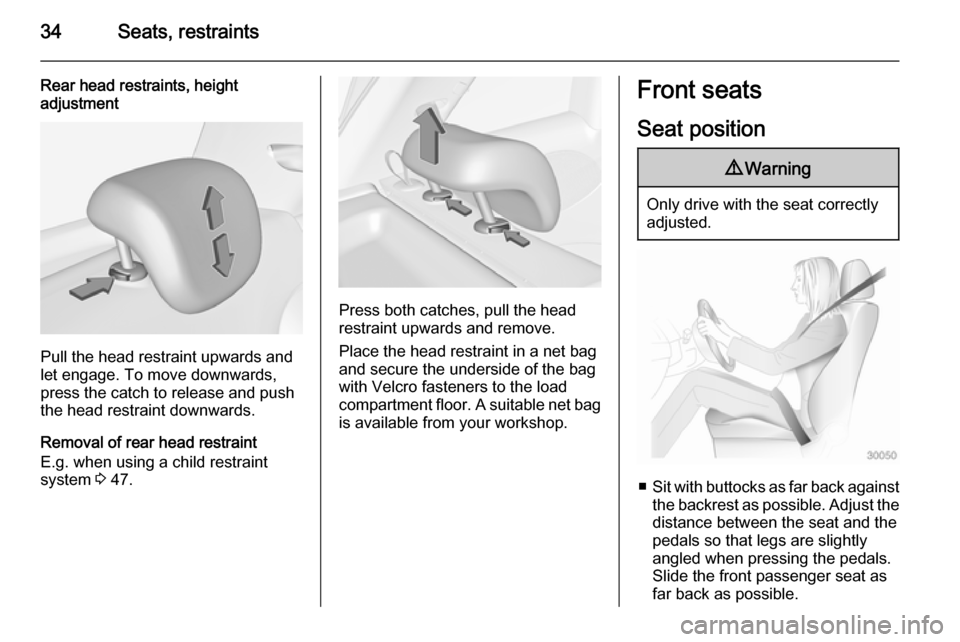
34Seats, restraints
Rear head restraints, height
adjustment
Pull the head restraint upwards and
let engage. To move downwards, press the catch to release and push
the head restraint downwards.
Removal of rear head restraint
E.g. when using a child restraint
system 3 47.
Press both catches, pull the head
restraint upwards and remove.
Place the head restraint in a net bag
and secure the underside of the bag
with Velcro fasteners to the load
compartment floor. A suitable net bag
is available from your workshop.
Front seats
Seat position9 Warning
Only drive with the seat correctly
adjusted.
■ Sit with buttocks as far back against
the backrest as possible. Adjust the distance between the seat and the
pedals so that legs are slightly
angled when pressing the pedals.
Slide the front passenger seat as
far back as possible.
Page 39 of 233
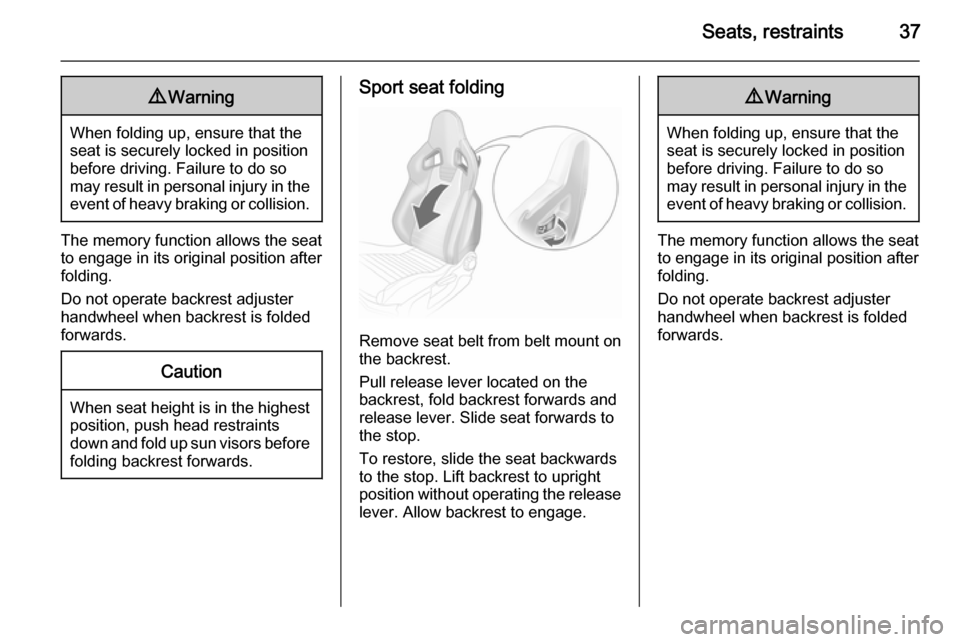
Seats, restraints379Warning
When folding up, ensure that the
seat is securely locked in position
before driving. Failure to do so
may result in personal injury in the event of heavy braking or collision.
The memory function allows the seat
to engage in its original position after
folding.
Do not operate backrest adjuster
handwheel when backrest is folded
forwards.
Caution
When seat height is in the highest position, push head restraints
down and fold up sun visors before
folding backrest forwards.
Sport seat folding
Remove seat belt from belt mount on
the backrest.
Pull release lever located on the
backrest, fold backrest forwards and
release lever. Slide seat forwards to
the stop.
To restore, slide the seat backwards
to the stop. Lift backrest to upright
position without operating the release lever. Allow backrest to engage.
9 Warning
When folding up, ensure that the
seat is securely locked in position
before driving. Failure to do so
may result in personal injury in the event of heavy braking or collision.
The memory function allows the seat
to engage in its original position after
folding.
Do not operate backrest adjuster
handwheel when backrest is folded
forwards.
Page 49 of 233
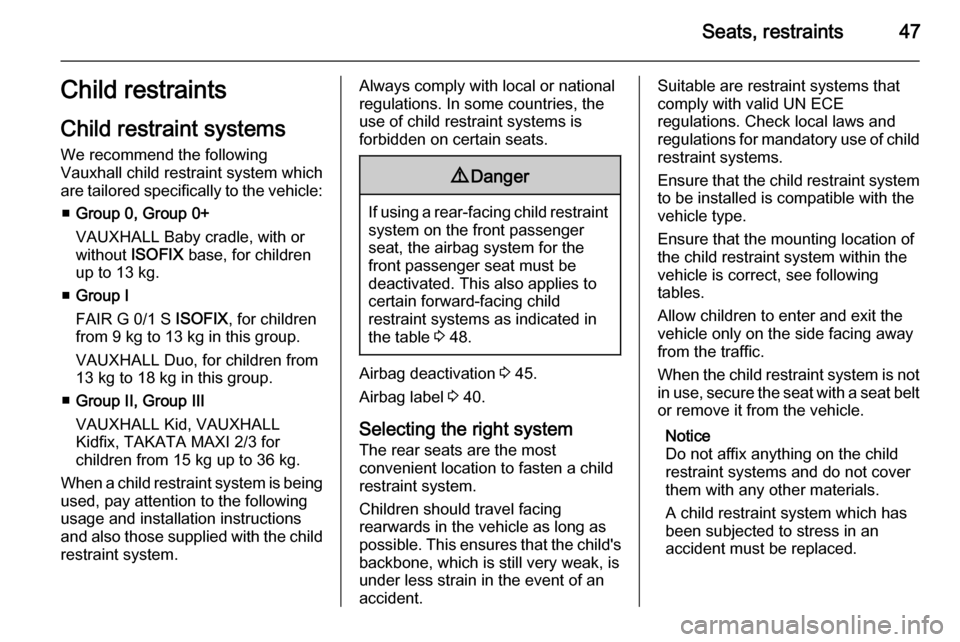
Seats, restraints47Child restraintsChild restraint systems
We recommend the following
Vauxhall child restraint system which are tailored specifically to the vehicle:
■ Group 0, Group 0+
VAUXHALL Baby cradle, with or
without ISOFIX base, for children
up to 13 kg.
■ Group I
FAIR G 0/1 S ISOFIX, for children
from 9 kg to 13 kg in this group.
VAUXHALL Duo, for children from
13 kg to 18 kg in this group.
■ Group II, Group III
VAUXHALL Kid, VAUXHALL
Kidfix, TAKATA MAXI 2/3 for
children from 15 kg up to 36 kg.
When a child restraint system is being
used, pay attention to the following
usage and installation instructions
and also those supplied with the child
restraint system.Always comply with local or national
regulations. In some countries, the
use of child restraint systems is
forbidden on certain seats.9 Danger
If using a rear-facing child restraint
system on the front passenger
seat, the airbag system for the
front passenger seat must be
deactivated. This also applies to
certain forward-facing child
restraint systems as indicated in
the table 3 48.
Airbag deactivation 3 45.
Airbag label 3 40.
Selecting the right system The rear seats are the most
convenient location to fasten a child restraint system.
Children should travel facing
rearwards in the vehicle as long as
possible. This ensures that the child's backbone, which is still very weak, is
under less strain in the event of an
accident.
Suitable are restraint systems that
comply with valid UN ECE
regulations. Check local laws and
regulations for mandatory use of child restraint systems.
Ensure that the child restraint system
to be installed is compatible with the
vehicle type.
Ensure that the mounting location of
the child restraint system within the
vehicle is correct, see following
tables.
Allow children to enter and exit the
vehicle only on the side facing away
from the traffic.
When the child restraint system is not in use, secure the seat with a seat beltor remove it from the vehicle.
Notice
Do not affix anything on the child
restraint systems and do not cover
them with any other materials.
A child restraint system which has
been subjected to stress in an
accident must be replaced.
Page 51 of 233

Seats, restraints49
1=if the child restraint system is being secured using a three-point seat belt, adjust seat backrest inclination to a verticalposition to ensure that the belt is tight on the buckle side. Move seat height adjustment in the uppermost position.2=remove rear head restraint when using child restraint systems in this group 3 33*=move the respective front seat ahead of the child restraint system to one of the foremost adjustment positions**=move the front passenger seat to the rearmost adjustment position. Move seat height adjustment to the uppermost
position and the headrest to the lowest position. Adjust seat backrest inclination as far as necessary to a vertical position to ensure that vehicle seat belt runs forwards from the upper anchorage pointU=universal suitability in conjunction with three-point seat beltX=no child restraint system permitted in this weight class
Permissible options for fitting an ISOFIX child restraint system
Weight classSize classFixtureOn front passenger seatOn rear seatsGroup 0: up to 10 kg
or approx. 10 monthsEISO/R1XIL *Group 0+: up to 13 kg
or approx. 2 yearsEISO/R1XIL *DISO/R2XXCISO/R3XX
Page 52 of 233

50Seats, restraints
Weight classSize classFixtureOn front passenger seatOn rear seatsGroup I: 9 to 18 kg
or approx. 8 months to 4 yearsDISO/R2XXCISO/R3XXBISO/F2XIL, IUF**B1ISO/F2XXIL, IUF**AISO/F3XIL, IUF**Group II: 15 to 25 kg
or approx. 3 to 7 yearsXILGroup III: 22 to 36 kg
or approx. 6 to 12 yearsXILIL=suitable for particular ISOFIX restraint systems of the "specific-vehicle", "restricted" or "semi-universal" categories.
The ISOFIX restraint system must be approved for the specific vehicle typeIUF=suitable for ISOFIX forward-facing child restraint systems of universal category approved for use in this weight classX=no ISOFIX child restraint system approved in this weight class*=move the respective front seat ahead of the child restraint system to one of the foremost adjustment positions**=remove respective rear head restraint when using child restraint systems in this size class 3 33
Page 54 of 233
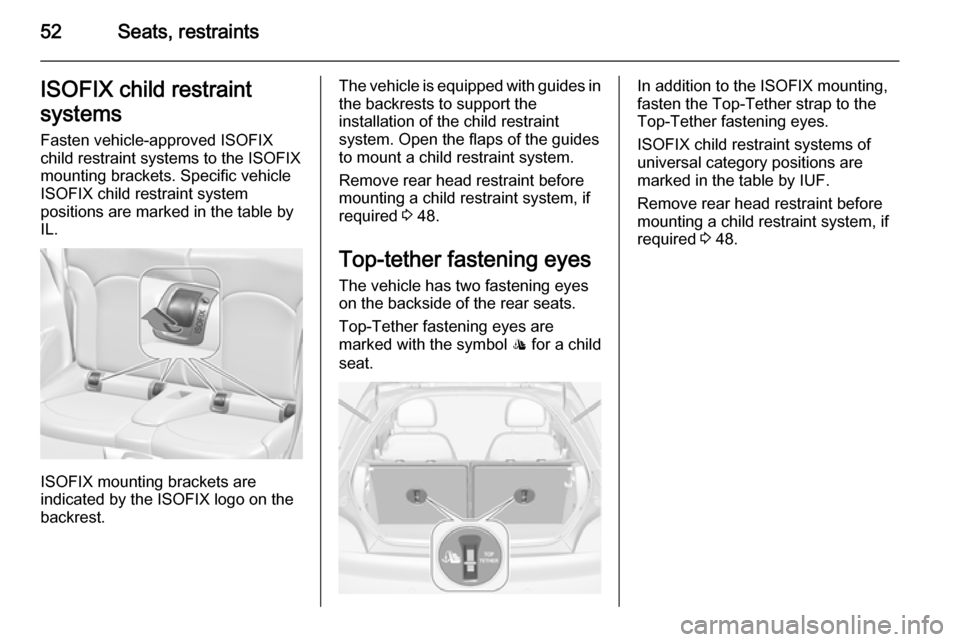
52Seats, restraintsISOFIX child restraint
systems Fasten vehicle-approved ISOFIX
child restraint systems to the ISOFIX
mounting brackets. Specific vehicle
ISOFIX child restraint system
positions are marked in the table by
IL.
ISOFIX mounting brackets are
indicated by the ISOFIX logo on the
backrest.
The vehicle is equipped with guides in the backrests to support the
installation of the child restraint
system. Open the flaps of the guides
to mount a child restraint system.
Remove rear head restraint before
mounting a child restraint system, if
required 3 48.
Top-tether fastening eyes The vehicle has two fastening eyes
on the backside of the rear seats.
Top-Tether fastening eyes are
marked with the symbol : for a child
seat.In addition to the ISOFIX mounting,
fasten the Top-Tether strap to the
Top-Tether fastening eyes.
ISOFIX child restraint systems of
universal category positions are
marked in the table by IUF.
Remove rear head restraint before
mounting a child restraint system, if
required 3 48.
Page 71 of 233

Storage69Warning triangle
The warning triangle is stowed with
elastic straps in the load
compartment below the tailgate.
If the vehicle is equipped with a
storage box in the load compartment,
remove the storage box to gain
access to the warning triangle 3 65.
Version with subwoofer box
Lift up the rear part of the floor cover. Pull the handle to remove the warning
triangle.
Rear floor storage cover 3 67.
First aid kit
Stow the first aid kit in the side panel
storage near the rear seats.
Page 72 of 233
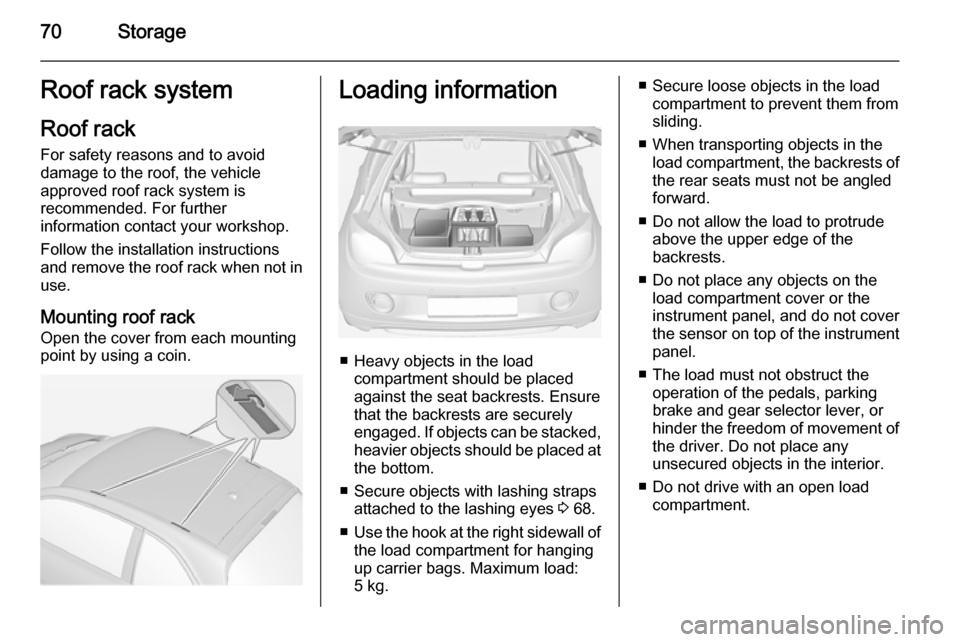
70StorageRoof rack systemRoof rack
For safety reasons and to avoid
damage to the roof, the vehicle
approved roof rack system is
recommended. For further
information contact your workshop.
Follow the installation instructions
and remove the roof rack when not in use.
Mounting roof rack Open the cover from each mounting
point by using a coin.Loading information
■ Heavy objects in the load compartment should be placedagainst the seat backrests. Ensure
that the backrests are securely
engaged. If objects can be stacked, heavier objects should be placed at
the bottom.
■ Secure objects with lashing straps attached to the lashing eyes 3 68.
■ Use the hook at the right sidewall of
the load compartment for hanging
up carrier bags. Maximum load: 5 kg.
■ Secure loose objects in the load compartment to prevent them from
sliding.
■ When transporting objects in the load compartment, the backrests ofthe rear seats must not be angled
forward.
■ Do not allow the load to protrude above the upper edge of the
backrests.
■ Do not place any objects on the load compartment cover or theinstrument panel, and do not cover
the sensor on top of the instrument
panel.
■ The load must not obstruct the operation of the pedals, parking
brake and gear selector lever, or
hinder the freedom of movement of the driver. Do not place any
unsecured objects in the interior.
■ Do not drive with an open load compartment.
Page 113 of 233
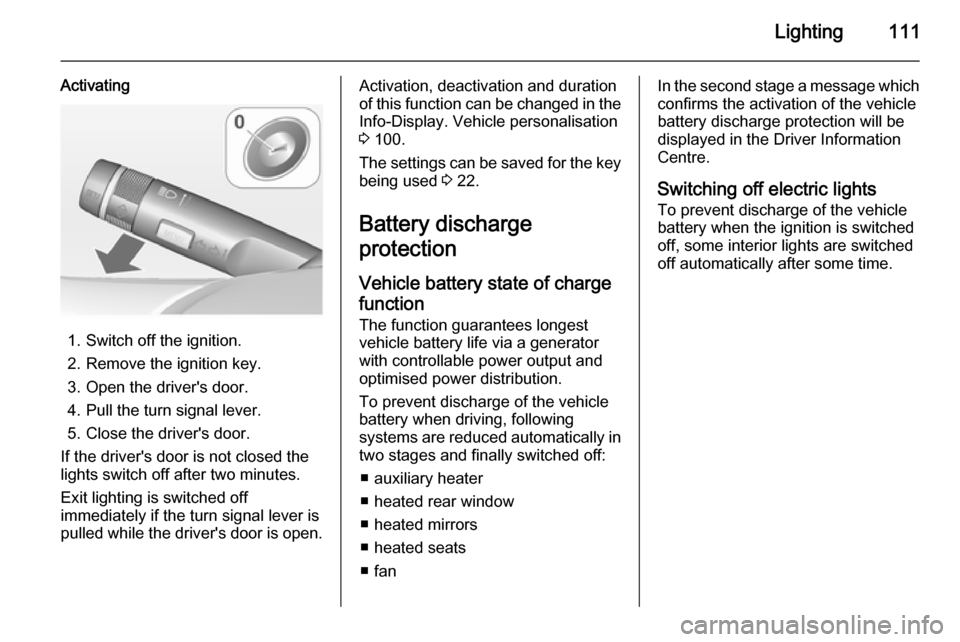
Lighting111
Activating
1. Switch off the ignition.
2. Remove the ignition key.
3. Open the driver's door.
4. Pull the turn signal lever.
5. Close the driver's door.
If the driver's door is not closed the
lights switch off after two minutes.
Exit lighting is switched off
immediately if the turn signal lever is
pulled while the driver's door is open.
Activation, deactivation and duration
of this function can be changed in the Info-Display. Vehicle personalisation
3 100.
The settings can be saved for the key being used 3 22.
Battery discharge
protection
Vehicle battery state of charge
function
The function guarantees longest
vehicle battery life via a generator with controllable power output and
optimised power distribution.
To prevent discharge of the vehicle
battery when driving, following
systems are reduced automatically in two stages and finally switched off:
■ auxiliary heater
■ heated rear window
■ heated mirrors
■ heated seats
■ fanIn the second stage a message which
confirms the activation of the vehicle
battery discharge protection will be
displayed in the Driver Information Centre.
Switching off electric lights To prevent discharge of the vehicle
battery when the ignition is switched
off, some interior lights are switched
off automatically after some time.
Page 198 of 233
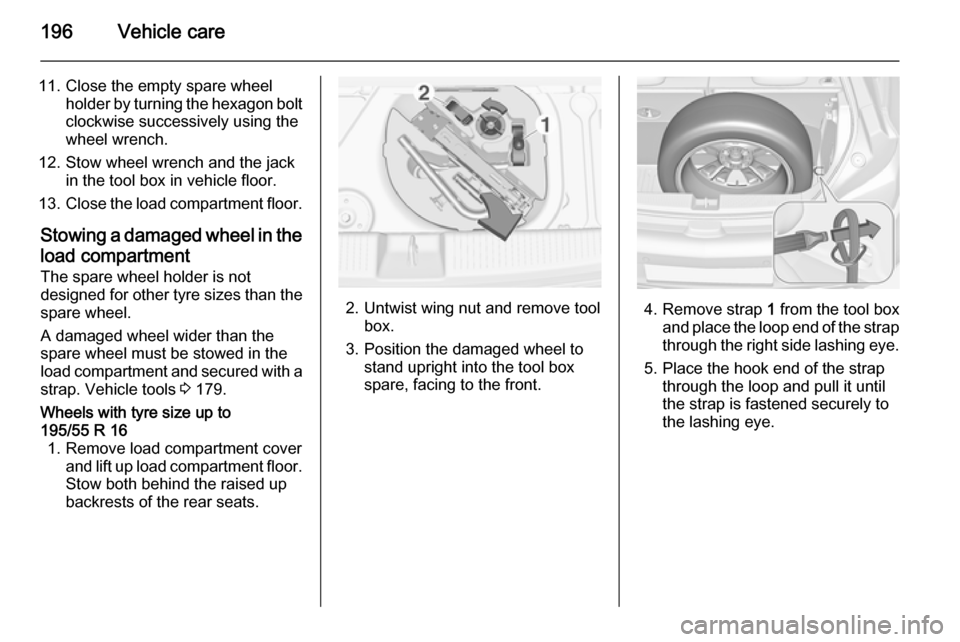
196Vehicle care
11. Close the empty spare wheelholder by turning the hexagon boltclockwise successively using the
wheel wrench.
12. Stow wheel wrench and the jack in the tool box in vehicle floor.
13. Close the load compartment floor.
Stowing a damaged wheel in the
load compartment The spare wheel holder is not
designed for other tyre sizes than the
spare wheel.
A damaged wheel wider than the
spare wheel must be stowed in the
load compartment and secured with a strap. Vehicle tools 3 179.Wheels with tyre size up to
195/55 R 16 1. Remove load compartment cover and lift up load compartment floor.
Stow both behind the raised up
backrests of the rear seats.
2. Untwist wing nut and remove tool box.
3. Position the damaged wheel to stand upright into the tool box
spare, facing to the front.4. Remove strap 1 from the tool box
and place the loop end of the strap
through the right side lashing eye.
5. Place the hook end of the strap through the loop and pull it until
the strap is fastened securely to
the lashing eye.